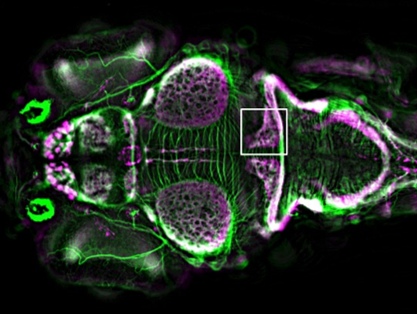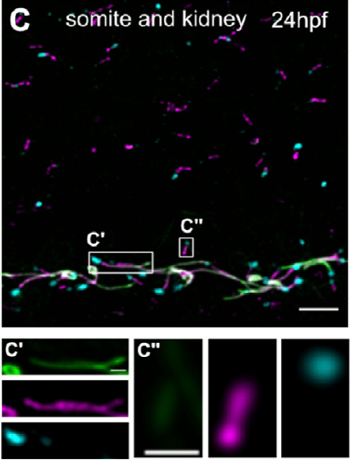Research
Genetics and Molecular Pathogenesis of monogenic developmental diseases affecting the brain, the kidney and/or the retina
The overarching goal of our research is to improve our understanding of the path leading from changes in our genes to developmental disorders, in order to improve our ability to predict the clinical outcome of affected patients. To reach this goal, we use a combined approach based on human genetics, iPSC-based cellular models and zebrafish genetics and biology and focus on three organ systems: the brain, the retina and the kidney.

Primary Cilia & Ciliopathies
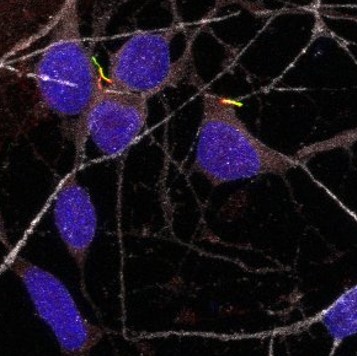
Our research predominantly focuses on the study of primary cilia, small non-motile organelles present on most vertebrate cells. Primary cilia serve as antennae transmitting sensory, mechanical or chemical information to the cell, and regulating signalling pathways during development and cell homeostasis. This variety of functions places the sudy of cilia at the crossroads of developmental biology, cell biology and genetics.
Dysfunction of cilia leads to a group of human disorders called ciliopathies, which can affect most organ systems. Typical symptoms include retinal degeneration, cystic kidney disease, skeletal abnormalities, brain malformations and/or cognitive dysfunction. Llike most monogenic disorders, ciliopathies display important genetic heterogeneity, where each individual disorder can be caused by mutations in tens of genes, and marked phenotypic variability, where individuals sharing the same causal mutations can display very different clinical pictures.
These poor genotype-phenotype correlations significantly complicate the clinical management for individuals with ciliopathies, especially for predicting the outcome in the prenatal setting and for progressive features such as retinal degeneration or renal insufficiency. They moreover suggest multiple diverse functions for cilia and cell-type specific roles for ciliary proteins.
Role of cilia in CNS development and function
Zebrafish models
We have collected and established multiple zebrafish lines harboring mutations in ciliary genes, predominantly for genes associated with Joubert syndrome in patients. In depth phenotypic analyses are ongoing to determine the CNS phenotype of the mutants, using advanced light imaging techniques and behavioral assays.
iPSC-derived 2D and 3D models
Taking advantage of the unique possibility to study human neurons in a dish, we have knocked out Joubert syndrome associated genes in iPSC using CRISPR and are applying 2D and 3D neuronal differentiation protocols to determine the cellular phenotype of human neurons lacking these disease-associated ciliary genes
Role of cilia in kidney
We are differentiating iPSC harboring mutations in cilia-associated genes using a 3D renal organoid protocol, to investigate the role of cilia in the developing human kidney and to identify the pathomechanisms underlying renal fibrosis and cystogenesis in ciliopathy patients.
Tissue-specificity of cilia
Since cilia fulfill such a wide range of functions, depending on the cell type, we hypothesize that ciliary protein composition will vary between different cilia. This project focuses on identifying the cell-type specific ciliary protein content through proteomics approaches by differentiating the same iPSCs into different cell types and by analyzing cilia from different tissues in the zebrafish
Cilia and body axis project
All zebrafish mutants established in the lab display larval body curvature and develop scoliosis as adults. This project focuses on the link between cilia in the central canal and body axis curvature.
PRAECLARE project: genetic variant interpretation
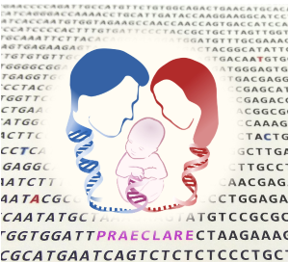
Next-generation sequencing has made it very easy to obtain the sequence of an individual’s genome, such that the current bottleneck lies in the interpretation of the clinical significance of the uncovered variants in our genes. This project aims at establishing a medium-throughput rescue assay to assist in interpreting the significance of novel missense variants of uncertain significance. The project ist supported by the Clinical Research Priority Program PRAECLARE. https://www.praeclare.uzh.ch/de.html
PREDICT project: Towards a PREcide Diagnosis in CiliopaThies

This project is supported by the European Joint Program on Rare Diseases and aims at improving our ability to predict the clinical outcome for patients with mutations in ciliopathy genes. Specifically, our multinational consortium is tackling the question of genetic modifiers in a selected subgroup of ciliopathies, in order to build models of genetic interactions.
https://www.ejprarediseases.org/predict/
PHRT project:

Under the umbrella of the personalized Health & Related Technologies of the ETH, this project is a collaboration with Pedro Beltrao (https://imsb.ethz.ch/research/beltrao.html). The idea is to use bio-informatic approaches that have been predominantly used for common diseases so far, in order to identify candidate ciliopathy genes and investigate ciliopathy genotype-phenotype interactions.
Neurodevelopmental disorders (AdaBD)
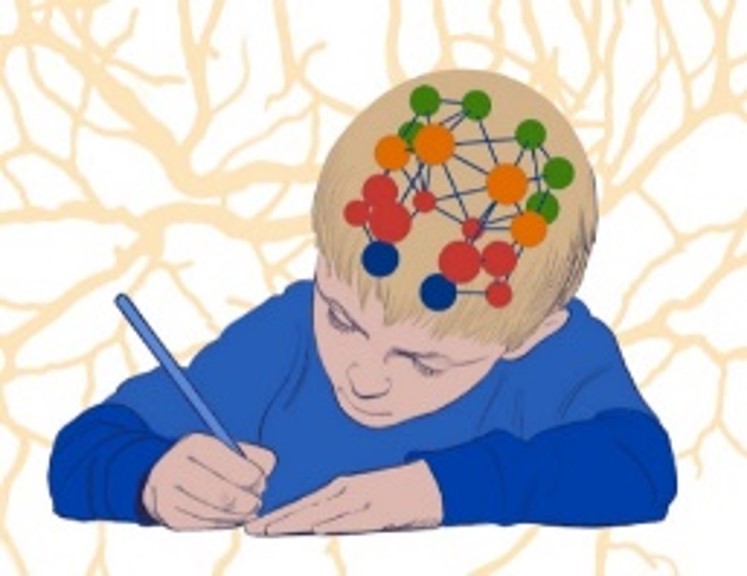
Under the umbrella of the University Research Priority Program Adaptive Neural Circuits (AdaBD), we are collaborating with other groups within the consortium to improve our understanding of how genetic mutations lead to neurodevelopmental disorders. https://www.adabd.uzh.ch/en.html
Inherited renal disorders
Our interest in ciliopathies has brought about a larger interest in other non-cilia related inherited renal disorders. Among other topics, we are studying the genetics of the Swiss Kidney Stone cohort (https://sksc.nccr-kidney.ch/).
